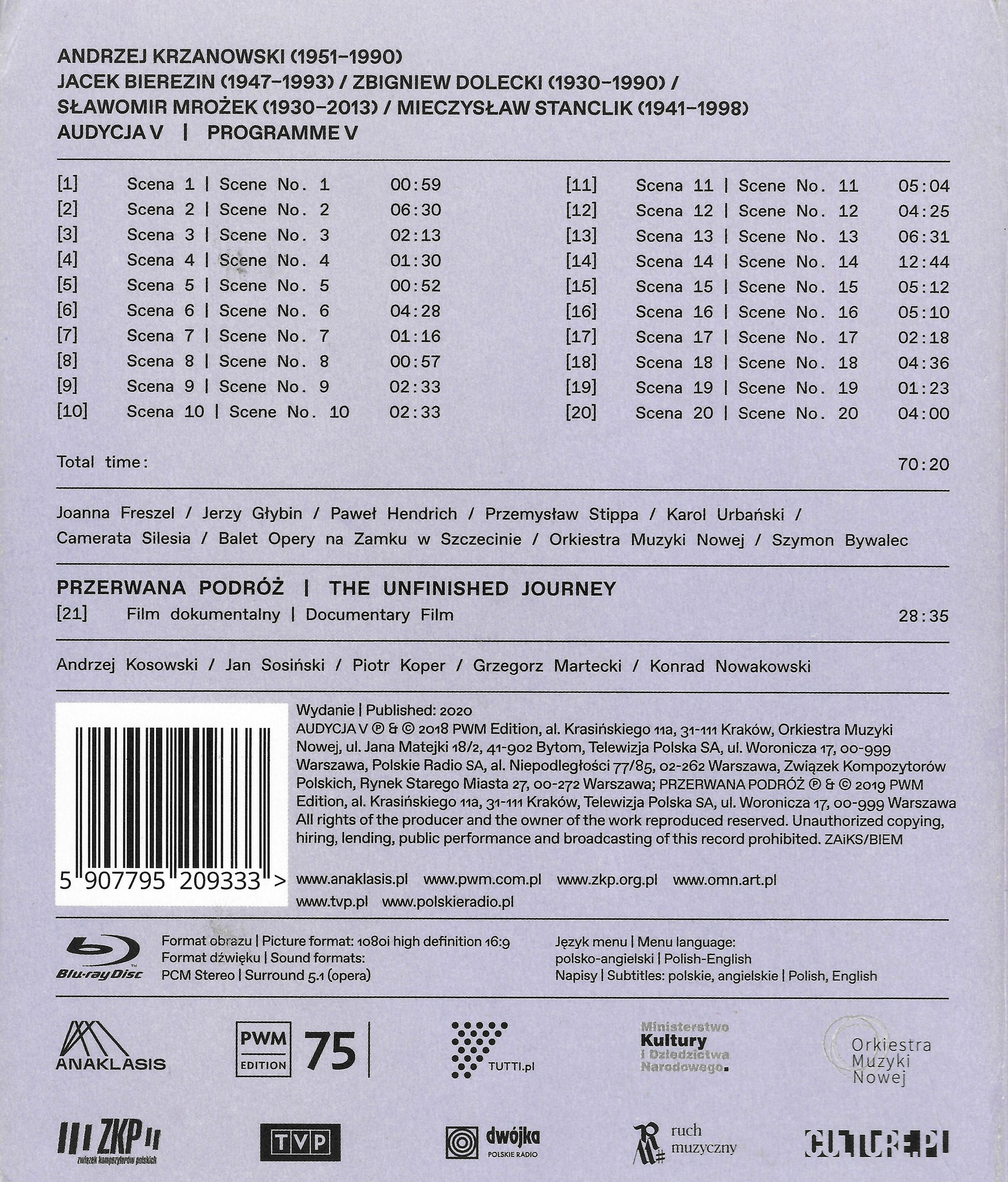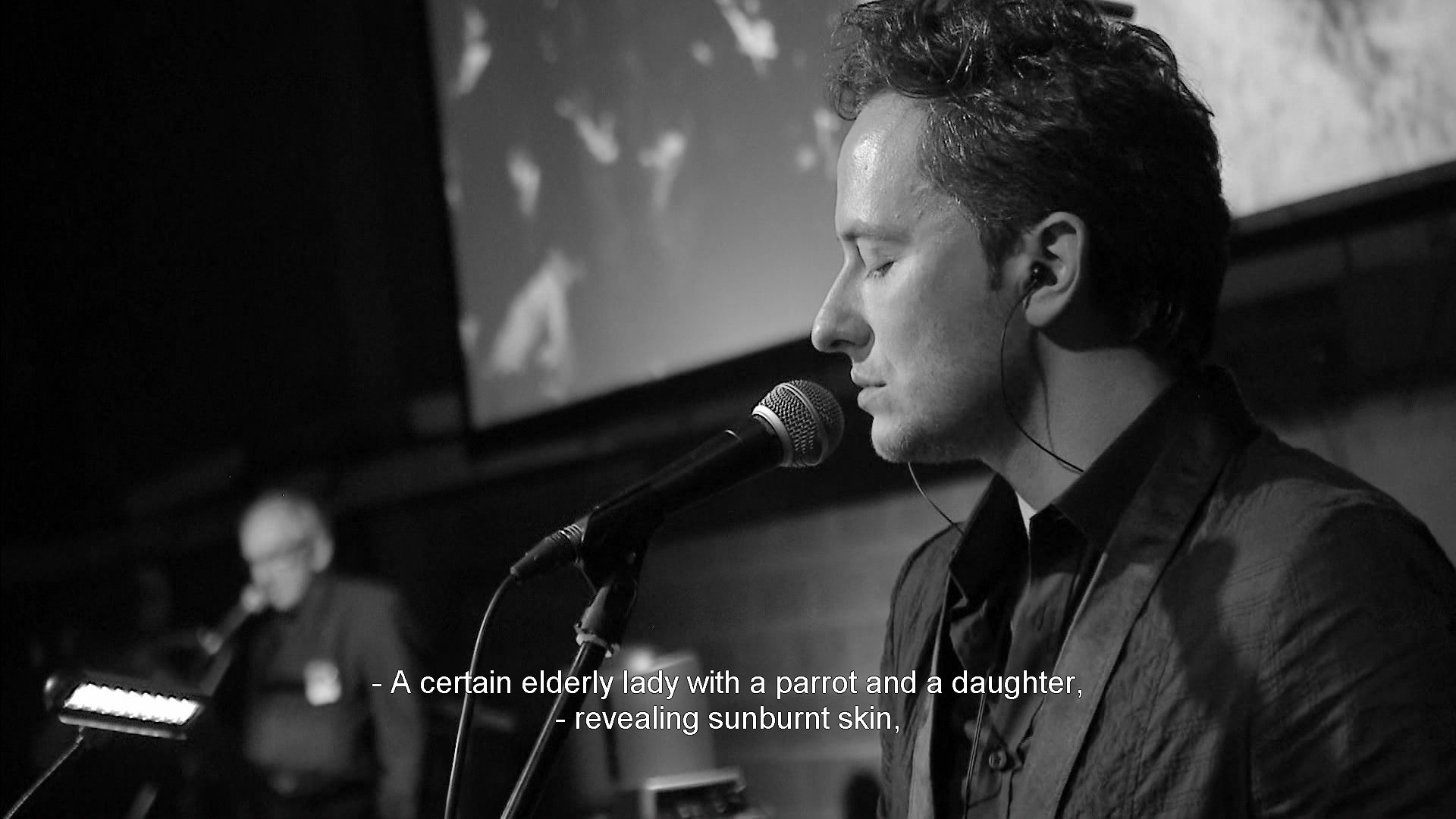

Programme V (Audycja V) opera. Music by the Pole Andrzej Krzanowski to his own libretto, which includes texts from Polish poets. Directed by Natalia Babińska on September 23, 2018 at the ATM studio in Warsaw as part of the Warsaw Autumn International Festival of Contemporary Music. Szymon Bywalec conducts the New Music Orchestra (Orkiestra Muzyki Nowej) and singers from the Katowice City Singers’ Ensemble (Camerata Silesia). Assistant conductor was Wojciech Wantulok and choirmaster was Anna Szostak. Tape music by Pawel Hendrich. There is only one solo singer: soprano Joanna Freszel. She is joined in solo roles by two actors who recite Polish poetry: Jerzy Głybin and Przemysław Stippa. Karol Urbański is mime and choreographer for dancers of the Szczecin Castle Opera Ballet. Staging and costume design by Klaudia Klimka; mulitmedia and film by Marian Oslislo, Krzysztof Zygalski, and Tomasz Strojecki; lighting by Piotr Sadlik. Directed for TV by Jacek Dybowski. Performed in Polish + Salve Regina in Latin. Subtitles in Polish and English. Released 2020, disc has 5.1 surround sound. Grade: B
Andrzej Krzanowski, born into a working class family, was known as the “Chopin of the accordion.” He wrote contemporary classical music for the accordion and other forces before dying at age 39. The opera Programme V is his most complicated work. It’s unusual (maybe unique) in that Andrzej served as his own Regiedirector by specifying in the score all elements of the mise-en-scène and multimedia aspects of the production. This, as lawyers like to say, includes, but is not limited to: 3 video screens in front with integrated content, taped music, a divided orchestra, a mine, ballet dancers, an accordion as concert master, a single solo singer, a chorus that mostly shouts, actors reading poetry, sign language, several scenes performed simultaneously, perfume squirting, free souvenirs, refreshments for the audience, and religious symbolism. I’m not sure, but I think some cast member were recruited from the audience. It appears this beast has been performed twice. This Blu-ray appears to be the only recording.
So let’s start our review with a screenshot below of the auditorium before the audience arrives. (Most of the video file is in black and white, but parts are in color.) This show probably can’t be performed in a regular theater. It needs to be in an empty box like this ATM studio in Warsaw where the performers and audience can be mixed up. There will be content on all three movie screens throughout. In the gloom on the right, the orchestra is warming up. A row of chairs on the right side wall will seat the chorus when they eventually arrive. The conductor will work at his podium (two bright lights) under the middle video screen. The solo singer and actors reciting poetry also appear under the center screen. There is a catwalk where the mime and dancers will perform when they are not roving about the room or in the midst of the audience. On the left sidewall you see in the gloom 5 figures in chairs. They are part of the orchestra who serve as additional noise makers:
Conductor Szymon Bywalec:
The orchestra is mostly brass with a handful of other instruments + lots of percussion:
The versatile woodwinds/noisemaker section:
This is a one singer + a small opera chorus. Joanna Friszel is amazing as human noisemaker. It would be fun to pit her against Barbara Hannigan in a Saga of the Sopranos. But the libretto gives her no word to sing in any language:
Huge percussion parts:
The chorus sings and shouts. But I don’t think they sing any words:
And let’s not forget the extra bank of noisemakers:
Karol Urbańsky as mime and choreographer for the ballet dancers:
It would appear the substantial video content is not just archive material—I think this is Urbańsky on the big screen also:
I think the dancers portray specific events, perhaps from prehistoric oral traditions, Polish folklore, and the Bible. But except for some obvious Catholic symbolism at the end of the opera, I was baffled by the dancing. Alas, the extensive and beautifully done keepcase booklet does not have a synopsis:
I never saw elsewhere the move below:
Is this Dionysus?
Next below we see Jerzy Głybin reciting poetry from Jacek Bierezin. The keepcase booklet does have complete texts for the poetry recitals in Polish and English. The poetry is also rendered in the subtitles in both languages:
A soulful portrait of actor Przemysław Stippa:
Maybe I let my imagination run wild. I don’t know sign language for the deaf. But Stippa is signing here (not singing) for poetry being recited by Głybin:
In the next two streenshots below, things get even wilder. The top line of the subtitles is recited by Głybin. The bottom line is recited by Stippa simultaneously. Two scenes from the opera are being presented together, each by a different actor. Even PWM Edition blew a fuse on this with confused information about the scenes on the video and in the keepcase booklet!
Some perfume squirters prepare to joint the fray while Sisyphus (?) tries to keep the world turning:
Sweets to reward the audience for putting up with all this:
But Agata Zubel is unhappy. Maybe they ran out of her favorite candy (probably licorice). In the background you see a battery of tech folks supporting and recording the show:
Now we approach the end of the opera in Scene 18 with Krzanowski’s version of the Salve Regina:
All the luminaries of Polish contemporary music flock to the Warsaw Autumn event. Below center is Grażyna Krzanowska, the composer’s widow (who was herself a musician and composer). She is thrilled by this rare event:
So what, as my nurse daughter would say, should we make of this hot mess? Plenty of creativity, originality, and respected Polish poetry. A lot of fine effort by many artists. But the work lacks a clear romantic or historical plot, which we normally view as the essence of all opera. It’s a modern music smorgasbord about something with a Polish slant.
But even my best Polish friend is unsure what that something is. Without a story, even the best and most intriguing things can baffle and get tiresome. So it might make a difference if one can figure out what the mime and dancers are up to.
But the truly bizarre aspect of this work is that this appears to an opera in which not a single word is sung live by a soloist or chorus member! The live voices only make tones or noises. (The singing at the end, including the Salve Regina, is, I think, prerecorded and played from tape.)
Here’s my take on this now. I think Andrzej tried to capture the entire history of human communication in 70 minutes:
The noises made by the singers represent pre-language used by early humans on the hunt or seeking sex.
Eventually, humans developed languages. The dancers enact mostly stories told orally by ancients such as Homer and perhaps by oral tradition story-tellers in old Poland as well.
The invention of the alphabet and writing vastly expanded the power and scope of human thinking and communication. This gave us literature, represented by Polish poetry and the Salve Regina.
And now we enter post-literature realms of human communication with computer memory, videos, accordions, sirens, found percussive instruments, TVs, surround sound, and Programme V.
Although mysterious, Programme V is an impressive achievement. Once you get over all the puzzles, there’s interesting and even beautiful music to enjoy. The PQ and SQ is good considering that everything was done from scratch in a public box and recorded in one take. I’m grading this B, which is a decent grade on this website.
My daydream would be to get a synopsis from someone at PWM Edition as to what the the director and choreographer had in mind when they instructed the dancers. Then maybe I could beef up this review and spring for a better grade.




























